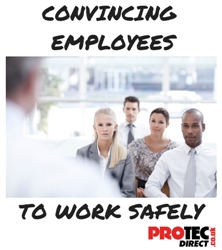Over the course of your lifetime you’ll more than likely spend a large chuck of it at work. Roughly 40 hours a week, about 48 weeks a year for 45 years adds up to a whole lot of time. So during these working years it’s important that you are working in a safe and comfortable environment.
Of course, thanks to many years of protest and progress, workers’ health and safety rights in the workplace are enshrined in law. Legally we are entitled to work in conditions that are as safe as is ‘reasonably possible’. That means we don’t have to do dangerous jobs unless every precaution and consideration of the risks and hazards has been assessed, leading to the use of appropriate safety equipment and PPE.
However, despite all the training, education, legislation and protection, accidents and fatalities continue to happen in UK workplaces. According to statistics from the Health and Safety Executive (HSE) for 2012/13, 148 people died in UK workplaces and a further 78,000 were injured. 1.1 million people were suffering from work-related illnesses and the cost of all workplace injuries and illnesses to society was estimated at £13.8 billion. Obviously the human cost is more significant but at a time of financial difficulty such a colossal amount of money is not to be sniffed at. Just think what that £13.8 billion could have been better used for.
Changing the mindset
What is clear is that despite the legal requirements put in place, sometimes all these efforts are not enough. Of course in some cases there will be rogue employers riding roughshod over their responsibilities and it is up to all of us to root them out and bring them to accountability for this. However, in many cases problems are caused by a failure on the employee’s part to embrace health and safety requirements. This can happen in a number of ways.
Firstly, in the same way as when you have toothache in one side of your mouth you simply switch to chew with the other, many people who suffer pain at work simply adapt their working routines to lessen the impact. Humans are very adaptable and the body is programmed to avoid physical pain. This is at best tackling the symptoms rather than the cause and will seldom lead to recovery.
This ‘putting up with the pain’ is far more common than we would like to think and to address it we need to institute a change of mindset. Rather than thinking your concerns will not be addressed or that somehow the pain being caused is inevitable, we need to get to a stage where people are comfortable raising concerns about their working conditions.
This change in mindset must be driven from a management level. Encourage your employers to talk about how they feel when they work. Ask them questions about their comfort and open clear channels of communication for them to raise issues. Use your management skills to encourage people to create a clearer vision of safety and comfort at work. In the long run this will be much better for business, with fewer illnesses, injuries and sick days being taken.
Education, education, education
People often don’t wear bicycle helmets for a number of reasons. These often include that they find them uncomfortable, they think they look silly or they are bulky and a nuisance to carry round. Yet it is something that could potentially save your life.
In the workplace, hard hats, safety goggles, dust masks and various other PPE are often not worn for similar reasons. It might not be much fun to wear a face mask and goggles when doing tough manual work but it is far more preferable than the alternative. It is estimated that around 4,000 people a year die from complications to do with dust inhalation at work. Serious heath concerns such as silicosis, asthma and even cancer are caused by long-term exposure to certain forms of construction dust.
Effective health and safety training will help to increase the impact of these numbers, making them more relevant than a simple statistic. Employees should be left in no doubt about why they are required to wear every part of their provided safety equipment.
Enforcement
As well as the carrot of education, sometimes it is necessary to back this up with the stick of discipline. If employees are not abiding by heath and safety law, you need to make it clear that this is unacceptable. Nobody likes to be the bad guy at work, but a clear disciplinary procedure around failure to follow safety requirements will help to convince employees of the importance of working safely.
Accidents are always going to happen – that’s their very nature. But by working together and encouraging everyone to buy into the importance of health and safety in the workplace, we can do as much as ‘reasonably possible’ to reduce their number.





Leave a comment